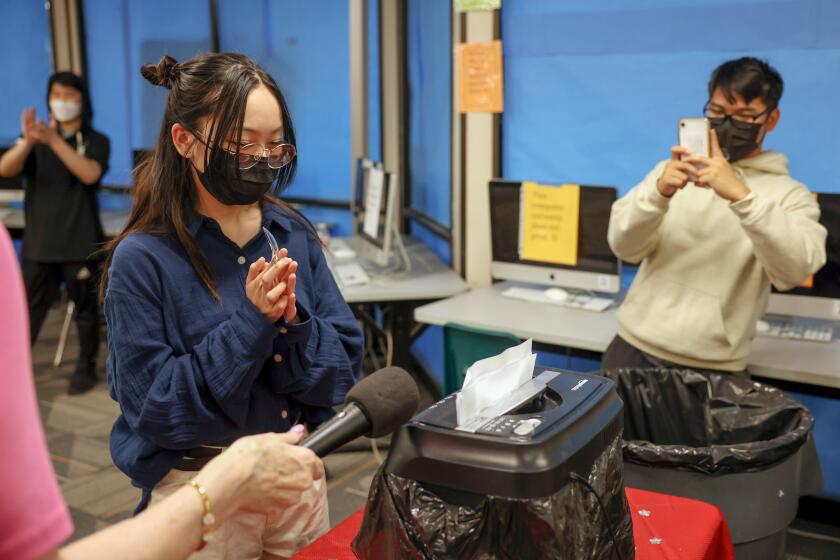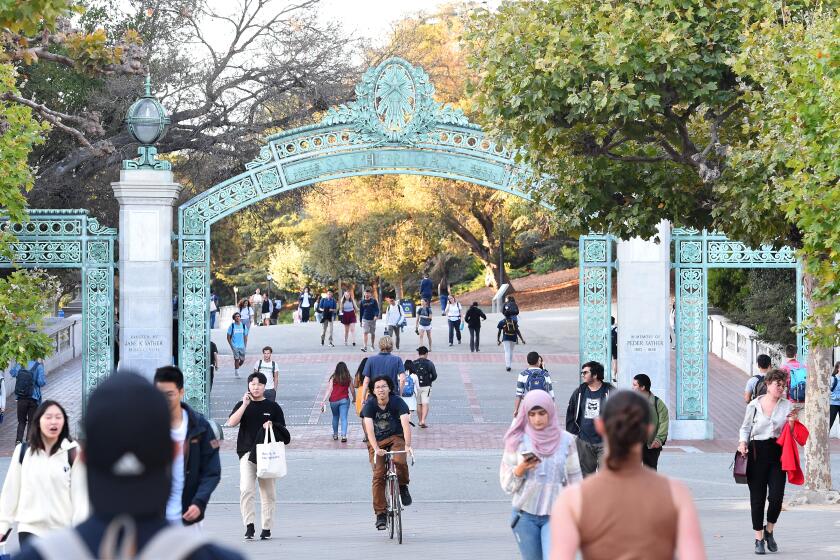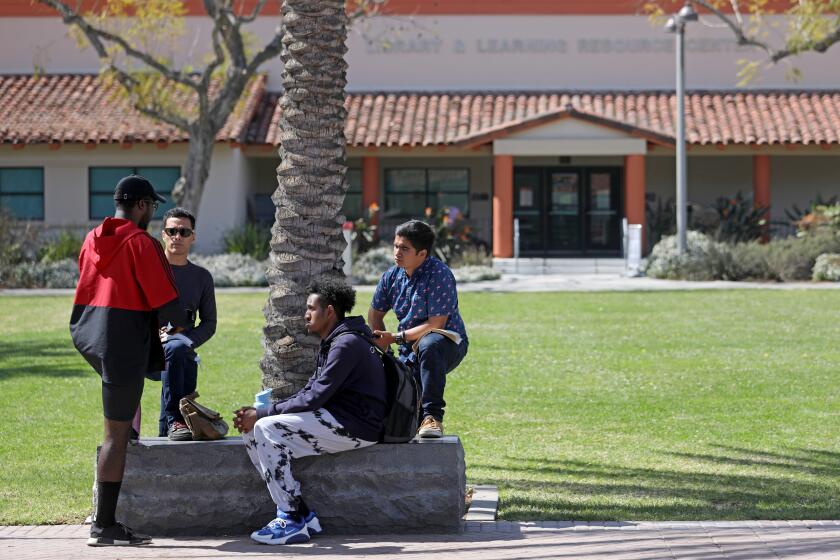Some student loans are in line for relief. What’s happening and what you should do now

Payments were set to resume May 1, but after calls from Democrats in Congress, the White House plans to give borrowers additional time.
- Share via
It’s been a good month for people weighed down by federal student-loan debt. First the Biden administration extended a moratorium on federal student loan payments and interest charges through August. Then on Tuesday the Education Department announced that it was reviewing payment records to give borrowers more credit for the progress they’ve been making toward loan forgiveness.
The latest changes apply to borrowers enrolled in an “income driven repayment” plan, which reduces loan payments for lower-income borrowers. The moves will shorten the amount of time before the borrowers’ federal student loans are forgiven — and in an estimated 40,000 cases, will immediately wipe out the borrower’s remaining balance.
Important reminder: The changes apply just to federal direct student loans, which represent the vast majority of outstanding debt, not to privately issued loans. And not every federal loan is eligible for an income-driven repayment plan, said Michele Streeter, associate director of policy and advocacy for the Institute for College Access & Success, although borrowers can consolidate their loans into an IDR-eligible one.
About 9 million borrowers are in IDR plans, representing about 30% of federal student loans, said Regan Fitzgerald, manager of Pew’s Project on Student Borrower Success.
If you are a borrower, you do not have to ask for the latest changes to be made to your account. The Education Department said it will begin applying them automatically, although you may not see the effect in your account until sometime in the last three months of 2022.
The announced changes will help borrowers already on the road to having their loans forgiven, but they stop well short of the proposals by Sen. Bernie Sanders (I-Vt.) and others who advocate simply erasing all or part of borrowers’ debt.
Nevertheless, there are steps you can and should take now to make sure you get the full benefit. Here is a quick summary of what the department is doing and how you should respond.
Inaccurate recordkeeping
IDR plans were designed to make college more accessible to lower-income people by limiting their monthly debt payments to 10% to 15% of their discretionary income, which is defined as the amount they earn above 150% of the federal poverty level. For a single borrower in California, that amount would be any income above $1,700 a month. If they earned less than 150% of the poverty line, their monthly payment would be $0.
These plans don’t automatically reduce your debt; in fact, the amount you owe will grow if your monthly payment is less than the amount of interest accrued. But if you keep up with your payments for 20 years after enrolling in an IDR plan for undergraduate loans, your remaining balance will be forgiven. (Loans for graduate students require 25 years of payments.)
That’s how the program is supposed to work. In practice, however, it’s been marred by recordkeeping lapses that have denied borrowers credit for months or even years of compliance. The Government Accountability Office highlighted these failures in a report this week.
To address the recordkeeping issues, the Federal Student Aid office “will do a one-time revision of IDR-qualifying payments for all Direct Student Loans and federally managed Federal Family Education Loan Program loans,” the Education Department said. The revision will give borrowers credit for any months in which they made payments, including before they consolidated their loans. They will also receive credit for any months before 2013 when their loan payments were deferred because of economic hardship.
If the revision brings borrowers up to the number of payments required for loan forgiveness, their loans will be canceled automatically, the department said. That’s ordinarily 240 to 300 monthly payments, but participants in the Public Service Loan Forgiveness Program would be eligible after 10 years of payments while working at a school, government agency or nonprofit company.
The department also pledged to do a better job tracking IDR payments in the future. Among other things, it said the Federal Student Aid site, StudentAid.gov, will begin showing borrowers their payment totals next year so they can monitor their progress toward forgiveness.
After months of suspense, these unentitled kids and new generation of California’s star college applicants finally get their admission decisions.
Forbearance steering
When borrowers tell the company servicing their loans that they’re having trouble making payments, the servicers are supposed to alert them about IDR plans and other lower-cost options, as well as the costs of having their loan go into forbearance — a temporary form of relief that reduces or suspends payments while allowing interest charges and debt to grow. But FSA reviews suggest that servicers steered borrowers repeatedly into forbearance when IDR would have been a better alternative, the department said. As a result, “long-term use of forbearance was remarkably widespread,” with more than one in eight borrowers from July 2009 to March 2020 being in forbearance for at least three years.
Why would a servicer do that when they make no more money off of borrowers in forbearance than they do off of borrowers in an IDR plan? Jaylon Herbin, outreach and policy manager at the Center for Responsible Lending, noted one possible incentive: Putting a borrower into forbearance is easier and less time-consuming.
To make up for forbearance steering, the department said it would count any previous forbearance of more than 12 consecutive months or more than 36 months in total as if the borrowers had stayed current on their loans when calculating progress toward forgiveness in an IDR plan. Borrowers steered into shorter periods of forbearance can ask for similar relief by filing a complaint with the FSA Ombudsman at StudentAid.gov/feedback.
FSA will make that adjustment to qualifying borrowers’ accounts later this year, the department said. Together, the adjustments for bad recordkeeping and forbearance steering are expected to move more than 3.6 million borrowers at least three years closer to loan forgiveness, the department estimated.
The last of the college-admissions decisions for the class of 2022 will land in the coming days. There’s a good chance that your child will face, or already is grappling with, one of the biggest disappointments of their life.
What you should do now
Cody Hounanian, executive director of the Student Debt Crisis Center, said the place to start is by having an account at studentaid.gov and making sure the agency has your up-to-date contact information. It’s also important to monitor the emails that the agency sends, he said, adding, “This is an opportunity for borrowers to make sure they’re plugged in.”
FSA also has created a page on its site where borrowers can find the latest information on the IDR revisions.
Herbin said it’s also important to nail down who your servicer is and what kind of loan you have — in particular, whether you’re in an IDR plan or the Public Service Loan Forgiveness program. Then, he said, you should figure out how many payments you’ve made under that plan or program.
For the record:
7:34 a.m. April 22, 2022An earlier version of this story misidentified the student loan servicing company Maximus as Maximum.
Because of the lengthy COVID-related moratorium on loan payments, many borrowers may have lost track of who their servicer is. Servicers come and go; the largest one, Navient, exited the federal student loan business last year, turning over its 5.6 million accounts to Maximus (which does business as Aidvantage). If you don’t know who your servicer is, check your account at studentaid.gov.
Once you’ve figured out which company is servicing your loan, you can call it and ask for an account of how many payments you’ve made toward loan forgiveness, Fitzgerald said. Then you should check that against your own records, and see how the count changes after the department’s new reforms are put in place.
If you don’t get credit for as much progress toward forgiveness as you deserve, the department advises you to file a complaint with your servicer. And if that complaint isn’t resolved to your satisfaction, you can take your case to the FSA.
In addition to obtaining records from your servicer, Streeter said that you should be able to download them from the Education Department’s National Student Loan Data System. But one problem with those downloads, Hounanian said, is that they’re long, dense and potentially confusing. “Most borrowers won’t be able to make much sense out of it,” he warned.
His group works with Savi, a company that helps borrowers figure out where they stand and explore options for paying off their debt. Borrowers should look to trusted groups in their community for that sort of help, he said, rather than reaching out to just any company offering to help borrowers online. There are plenty of debt-relief scammers out there, Hounanian said, and “when borrowers are confused, that’s when these companies pounce.”
The COVID-related moratorium on student loan payments has helped borrowers in many ways, including when it comes to IDR forgiveness. If your IDR plan calls for you to pay $0 each month, the Education Department said in an email, you will get credit for the months when payments have been optional.
New research suggests colleges’ policies around unpaid balances may be contributing to an enrollment decline while doing lasting financial harm to students.
More to Read
Totally Worth It
Be your money's boss! Learn how to make a budget and take control of your finances with this eight-week newsletter course.
You may occasionally receive promotional content from the Los Angeles Times.














